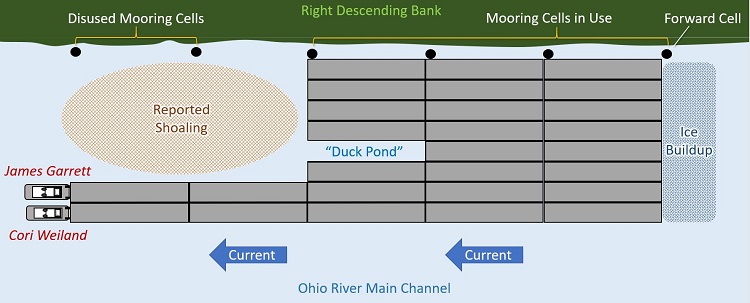NTSB Recommends Changes to Barge Fleeting Area Management
The National Transportation Safety Board (NTSB) has issued Marine Accident Brief 19/11 containing three safety recommendations issued to the U.S. Coast Guard and the U.S. Army Corps of Engineers.
The recommendations are based on findings of the NTSB’s investigation of a January 13, 2018, incident involving a 27 dry-cargo barge breakaway from the Jacks Run fleeting area on the Ohio River near Emsworth, Pennsylvania. The breakaway caused $12.5 million in damage, including the total constructive loss of two Army Corps of Engineers vessels. Of the 27 barges involved in the breakaway, seven were lost, and all but one of the 20 remaining barges required repairs.
While the dams at the Army Corps of Engineers Emsworth Locks and Dams complex were struck, the accident did not cause structural damage to the dams. An unknown amount of coal and cement was released into the Ohio River. There were no injuries reported in connection to the accident.
Record rainfall on January 12, 2018, caused a water level rise of more than 12 feet in the six hours preceding the breakaway. Earlier in January, freezing temperatures at night and above freezing temperatures during the day, caused ice formations on the river to thaw, break free and float down river before freezing again, resulting in ice buildup at the head of the barge flotilla moored in the Jacks Run fleeting area.

This NTSB graphic illustrates the shoaling, ice buildup and the barge arrangement at Jacks Run fleeting area prior to the Jan. 13, 2018, barge breakaway. The head of the barge flotilla is to the right. NTSB graphic.)
The NTSB’s investigation determined the failure to prevent shoaling and to maintain the fleeting area’s mooring cells, resulted in inadequate mooring arrangements during highwater and ice conditions which caused the barge breakaway. The U.S. Army Corps of Engineers’ and U.S. Coast Guard’s lack of resources and authority to effectively inspect fleeting areas and to ensure fleeting areas are maintained contributed to the accident, according to the NTSB’s Marine Accident Brief.
The first safety recommendation issued to the Army Corps of Engineers seeks a requirement for fleeting area permittees to submit waterfront facility operations guides to the Army Corps of Engineers for review to ensure adequate operating procedures for highwater and ice as well as adequate maintenance procedures.
The second recommendation was issued to both the Coast Guard and the Army Corps of Engineers, seeking a joint policy to ensure fleeting areas are maintained in compliance with permit requirements.
The third recommendation, issued to the Coast Guard, seeks development of a regulated navigation area for the Pittsburgh, Pennsylvania, region to ensure the integrity of fleeting areas, with detailed requirements for barge moorings during highwater and ice conditions.
Marine Accident Brief 19/11 is available here.
